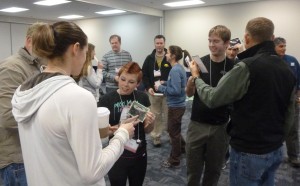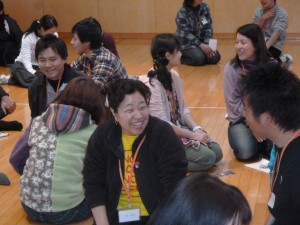Feb 03, 2013 Trade and Share: An Active Reflection and Dialogue Activity to Get Participants Moving, Talking, Reflecting and Keep Them Engaged
Over the last couple of years I’ve posted about a number of twists on activities traditionally used as icebreakers that I re-purpose as active, social approaches to reflection, processing or academic review. These active dialogue activities not only help group members connect and build rapport early on in a program, they are also a great way to facilitate reflection and exploration of academic or training content at any point. Strategies such as these build comfort with reflective practice by allowing group members to share with one person at a time before being asked to share with the entire group. These partner sharing and small group reflection approaches are a great alternative to didactic question and answer sessions, as everyone is involved in reflecting, talking and sharing rather than just the “hand raisers”.

In past posts on this subject I shared some of my favorite “upcycled icebreakers” “Handshake Mingle”, “Concentric Circles”“Have You Ever” and “Commonalities Mingle” and community building activities such as “Play dough Pictionary”, “Charades Race” for reflection or review. “Trade and Share” has become one of my favorites for building rapport between group members in a training, for celebrating the strengths of colleagues or students in an ongoing work group or class, or as an interactive way to review academic or training content. I use this as an extension of metaphoric “entry tasks” or reflection activities such as postcards, Conversation Starter Buttons, or keyboard keys. In the next few posts I will share variations of this activity for all of these purposes. Here is a version for extending an introductory or reflection activity, goal-setting, and helping participants learn more about their colleagues or classmates.
Trade and Share:
This variation on what many know as the “Nametag Trade” ice breaker can be adapted as a playful way to engage group members in dialogue about themselves, their opinions or goals for a program or class. This extension of the entry task or “hook” activities outlined in previous posts is as a way for participants to share about their object, button, keyboard key, or postcard choices in an interactive way. It is an effective strategy to help participants learn more about each other, practice active listening, facilitate introductions, or reflect on a specific experience or academic lesson. In upcoming posts I will share some examples of using this activity for all of these purposes.
Last winter during a workshop at the T.E.A.M Conference in Chicago, I was promoting the idea of re-purposing icebreakers as reflective approaches, my colleague Ed Caplan shared this idea of blending this trade activity with the entry task we used when participants walked in the door. We used my set of Quotables as a “hook” or entry task that day. He suggested this adaptation of the nametag trade activity to our group as a way to share our quotes and our reflections about whey we chose them with each other.

Facilitation Suggestions:
- Ask participants to share with a partner their name, and why they chose their object, image, postcard, quote, key or button and temporarily trade them with each other.
- Next they visit another person and trade that objects and story for a total of two to three trades.
- After a few minutes of trading, the group comes back together and participants introduce the person whose item they ended up with. I am careful to mention that this is an experiment in active listening and not a test. It helps them to know that their fellow group members will help them out if they don’t get everything right in their “report out”.
- I invite the sharer to hand the object back to the person and welcome them to add any additional information or clarifications to the introduction given.
Facilitation Notes:
The day Ed and I tried this in my workshop we found that only 2-3 trades were necessary. More than that becomes confusing. I find that postcards and objects often work better than the quotes in this particular activity as the objects and images are easier to remember. I tend to use this activity with more visual items like the buttons, postcards or keyboard keys. This activity is best done after the group spends some time together warming up with other simpler introductory activities (such as handshake mingle).
Outcomes:
I am impressed with how groups really buy into this activity-especially when I am careful to mention that this is an experiment in active listening and not a test. This game models to participants that their fellow group members will help them out. Because of the multiple trades it actually seems to take some pressure off group members and become more playful compared to a more formal single partner introduction activity.

Recently I used this with high school teachers who attended a course I taught on strategies to enhance advisory groups and spice up academic lessons. During one of our sessions we traded and shared using computer keyboard keys that they chose to represent “a goal they have for their teaching in the coming year”. The next day I received this note from one of the teachers in my class:
“I tried the trading activity with one of my classes and it was great! I didn’t have computer keys or anything for them to trade, so I just had them grab something, anything from their bag or their pockets to represent why music was important to them. They used phones, jewelry, a water bottle, a book, whatever they could find. While in most cases the item didn’t have any real significance, it worked really well to express their ideas. They loved it and they had some really good feedback about the activity
Lynn Sweet Mount Anthony Union Highschool
In the next few posts I will share more examples of using this method for reflecting on personal strengths and for reflection and review of academic content. I hope this post inspires you to upcycle items from your junk drawer as facilitation tools and re-purpose your favorite introductory activities for reflection or review. As discussed in previous articles, I try to encourage educators to expand their view of reflection as an ongoing engaging part of programs or lessons rather than just a “follow up” or “debrief” of a single activity or lesson. Interactive dialogue activities such as Trade and Share are ways to integrate reflective practice throughout a program from beginning to end.
Reference: Ed Caplan shared this idea of blending the “trade” activity with the entry task objects during one of my workshops last winter. He said he was inspired by a similar activity Chris Cavert shared in the Chiji Guidebook by Chris Cavert and Steven Simpson “That Person Over There”. Many know a similar “Nametag Trade” activity.



Jen Lara
Posted at 06:59h, 27 FebruaryThanks for the great ideas, Jen. You’ve inspired me once again.
Best,
Jen